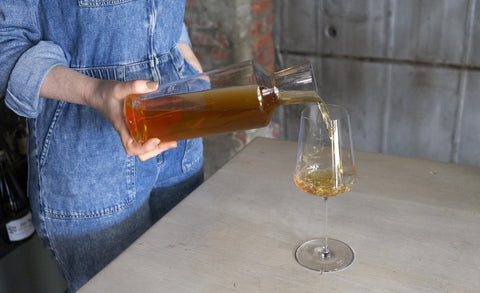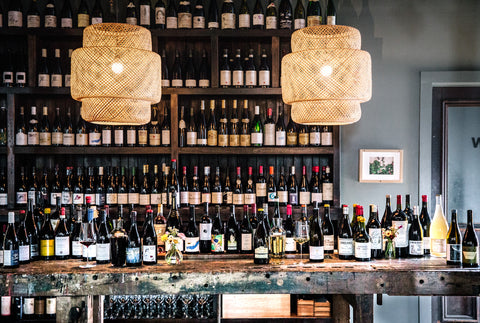Just when you thought wine could be organized into tidy categories: white, red, or rosé, orange comes along. Over the last decade, orange wine has inspired a cult following among natural wine drinkers. And with an increasing number of restaurant wine lists featuring sections titled “Amber Wine,” “Skin Contact,” or even “Macération,” you might be wondering what you’re getting yourself into.
In this Dispatch, you'll discover how orange wine is made — and gets its signature color — and the history of the style. Because even though it's become a trend, this is one of the oldest styles of wine in the world. Ready to dive in?
How Orange Wine Gets Its Appearance
It's an easy mistake to make, and one we hear a lot. But no, orange wine isn’t made from oranges. It's made from white grapes. Grape skins contain pigment, flavor compounds, and tannin (a type of phenolic compound). It’s up to the winemaker to decide if they want the skins to influence how the wine looks, tastes, and feels. Orange wine is produced with skin contact of white grapes, hence the wines other name: skin-contact white wine.
Instead of gently pressing grapes and immediately removing the skins to leave clear juice behind, like in white winemaking, orange wine orange wine is made by crushing white grapes and allowing the skins and seeds to spend time with the juice. During this period of maceration, color, flavor, and tannin seep into the juice.
Maceration can last anywhere from a few hours to several months depending on the winemaker’s vision for the wine. The longer the maceration, the more extraction, and the more influence the skins have on the wine’s appearance, aromatic profile, and structure.
All red wine is made with skin contact of red grapes. With its crush-and-macerate winemaking process, orange wine is like the red-wine version of white wine. It may seem like orange wine is a new, experimental style; but, it’s actually more of a throwback to ancient winemaking.
Who Makes Orange Wine?
Winemakers in Kakheti, Georgia—a region at the intersection of Europe and Asia—have been fermenting white grapes with their skins for over 5,000 years. These beautiful amber wines are typically made in qvevri, egg-shaped terracotta pots, also known as amphora. Wine is fermented, aged, and stored in these handmade clay vessels that are buried underground. The natural subterranean climate keeps the wine at the ideal temperature for slow fermentation.
Pro tip: Amphorae are heavily associated with orange winemaking, though their use is not a requirement. Not all orange wines will be made in amphorae; however, most amphora white wines will see some skin contact.
Outside of the Caucasus region, a group of winemakers on the Italy-Slovenia border in Friuli-Venezia-Giulia are resurrecting old traditions. In 2000, winemaker Josko Gravner traveled to Georgia, the birthplace of the vine. While visiting, he tasted white wines with extensive skin contact (several months). He was enchanted and enlightened. He decided to bring back these ancient winemaking methods to his home winery in Oslavia, Italy. In 2001, he made his first amphora wine with skin contact. Now, Gravner uses amphorae to ferment all of his wines. His wines spend six to seven months on the skins before being moved to large oak barrels for additional aging.
Image courtesy of Rosenthal Wine Merchant
Pro tip: Though some of these wines display a glowing orange color in the glass, most of the time the back label of the wine bottle reads: “white wine” instead of “orange wine.” Winemakers in regions like Georgia, Slovenia, and northern Italy, don’t consider their skin-contact wines a separate category from “white wine.” Sometimes you’ll see Georgian, qvevri-aged wines referred to as “amber wines.”
At Radikon, just a short walk from Gravner’s winery, winemaking is inspired by how previous generations in Slovenia have made wine. Amphora is not part of the program, but all wines are made with hand-harvested grapes and extended skin contact, and fermentation and aging occur in large old oak barrels. According to wine importer Louis/Dressner Selections, when Stanko Radikon was asked why he made his wines the way he did, he shrugged and replied, “it’s how my grandfather made wine in the 30s.”
It All Comes Down to the Yeast
It makes sense that ancient white winemaking included skin contact. In order to create wine, you need alcoholic fermentation. In the most basic, low-intervention, natural winemaking, the main components of alcoholic fermentation come from the grape: natural sugar from the grape juice and naturally-occuring yeast from the outer coating of the grape’s skin, called the bloom.
Pro tip: The naturally-occurring yeast on the grape skin is referred to as native, wild, ambient, or indigenous yeast. This is an essential element of natural winemaking.
Thousands of years ago, winemakers didn’t have the option to purchase commercial yeast, so if they wanted to ferment grapes, they needed that native yeast. Winemakers crushed the grapes to let the yeast meet up with the juice. During maceration and fermentation, it was unavoidable for another element to enter the wine: tannin. Tannin, a phenolic compound that causes the gum-gripping, mouth-drying sensation you experience when you drink red wine, can also be found in some white grapes. In addition to adding texture to a wine, tannin acts as a preservative, protecting the wine from oxidation. With the help of this natural protectant, the addition of sulfur dioxide (sulfites) is significantly less common with skin contact wines. The inclusion of tannin also increases the age-ability of skin-contact wines. Bottles from Gravner and Radikon are great candidates for cellaring.
How to Enjoy Orange Wine
The red-wine-like structure of some orange wines, combined with their slightly nutty and sometimes sherry-like (oxidative), briny, and ripe stone-fruit aromatic profiles make them a gorgeous candidate for food pairing. There is power and an undeniable complexity to these wines.
When I open a bottle from Josko Gravner, Paolo Vodopivec, or Dario Prinčič, I immediately reach for a tin of José Gourmet Small Smoked Sardines, a plate of Prosciutto di San Daniele, or a bowl of tortellini en brodo.
With orange wines from Sicily, like those made by Grottafumata and COS, I love to toss conserva Matiz Gallego Wild Pulpo in Spanish Olive Oil (tinned octopus from Galicia) with pasta like Rustichella d'Abruzzo Tonnarelli al Nero di Seppia (a squid ink pasta) and a simple garlic white wine sauce. Top with a generous amount of Parmesan, lemon, and fresh herbs.
Orange Wine Today
Winemakers around the world have taken inspiration from these ancient practices, and the various interpretations have led to a diverse selection of wines. Orange wine’s name is as vague as the selection is large. Some are pale gold while others are a glowing amber; some deliver exotic, floral aromas, while others are briny, savory, and feel more like red wine texturally than white. Some are even sparkling, like Milan Nestarec’s Danger 380 Volts from the Czech Republic. We love the vibrant wines from Gabrio Bini and Arianna Occhipinti in Sicily, the expressive wines made by Oriol Artigas and Goyo Garcia Viadero in Spain, the experimental wines from Anne & Jean-François Ganevat in the Jura, and the aromatic hybrid wines from Iapetus in Vermont.
If you’re curious about trying orange wine, next time you’re at Dedalus, just ask us: “do you have any skin-contact whites?” Or shop our collection of orange wines right here!





